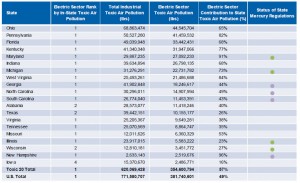
Florida is the 6th worst state in the nation when it comes to exposing residents to toxic air pollution from coal-fired power plants, according to an analysis released today in Florida by the Natural Resources Defense Council (NRDC).
Florida’s electric sector ranked 6th in industrial toxic air pollution in 2010, emitting nearly 16.7 million pounds of harmful chemicals, which accounted for 57 percent of state pollution and about 5 percent of toxic pollution from all U.S. power plants.
Florida ranked 15th among all states in industrial mercury air pollution from power plants, with about 1,710 pounds emitted in 2010, which accounted for 75 percent of state mercury air pollution and 3 percent of U.S. electric sector mercury pollution. Mercury contaminates fish and is most commonly absorbed by humans through fish consumption. Mercury poisoning can impair vision, speech and coordination, and lead to severe birth defects or worse.
On the national level, the report found a 19 percent decrease nationally in all air toxics emitted from power plants in 2010, the most recent data available, compared to 2009 levels. The welcomed drop, which also includes a 4 percent decrease in mercury emissions, results from two key factors. One is the increasing use by power companies of natural gas, which has become cheaper and is cleaner burning than coal; the other is the installation of state-of-the-art pollution controls by many plants–in anticipation of new health protections issued by the Environmental Protection Agency.
In 2011, Florida was second only to Texas in electricity generation from natural gas, at 62 percent of total power generated. Coal accounted for 23 percent, the State’s three nuclear power plants accounted for 9.8 percent, and other resources, including renewable energy, accounted for the remainder, according to the U.S. Energy Information Administration. Florida’s shift from coal to natural gas has been dramatic over the years. In 2000, coal accounted for 28 percent of power generation, compared to 29 percent for natural gas.
Eight of Florida’s 10 largest power plants are fueled by natural gas, including the largest, Florida Power & Light’s 3,695 megawatt plant in Martin County. Progress Energy’s Crystal River power plant is the largest coal-fired plant in the state, with a capacity of 3,151 megawatts.
Despite the shift to natural gas, Florida’s total emission of carbon dioxide, a greenhouse gas that contributes to global warming, has been increasing–from 91 million tons in 1990 to 124 million tons in 2010. Sulfur dioxide emissions, on the other hand–which is harmful to health and breathing–have plummeted, from 633,000 tons in 1990 to 160,000 tons in 2010.
Those reductions are the direct result of government intervention and regulation.
“Toxic pollution is already being reduced as a result of EPA’s health-protecting standards,” said John Walke, NRDC’s clean air director. “Thanks to the agency’s latest safeguards, millions of children and their families in the states hardest hit by toxic air pollution from power plants will be able to breathe easier.’’
“But these protections are threatened,” Walke said, “because polluters are intent on persuading future Congresses or presidential administrations to repeal them.”
Finalized in 2011, EPA’s Mercury and Air Toxics standards will cut mercury air pollution by 79 percent from 2010 levels, beginning in 2015.
Sen. James Inhofe, R.-Okla., attempted in June to repeal mercury and air toxics standard. He called the new the Mercury and Air Toxic Standards rule, issued by the EPA last year, “one of the most expensive Environmental Protection Agency rules in history,” and described it as “the centerpiece of President Obama’s war on coal.”
“This rule will destroy jobs and cause energy prices to skyrocket,” Inhofe claimed. “By voting for my resolution, SJR 37, members of the Senate can prevent the Obama EPA from inflicting so much economic pain on American families.” Florida Sen. Bill Nelson, a Democrat, opposed the Inhofe resolution. Sen. Marco Rubio, a Republican, supported it. The final vote was 56 opposed, 46 for.
Franz Matzner, NRDC associate director of Government Affairs, said: “For too long, Americans have had no choice but to breathe toxic air pollution. Thanks to the EPA, the air is getting cleaner. But we need lawmakers who will help clean up the air we all breathe — not lawmakers who do the bidding of Big Polluters trying to repeal safeguards that protect children’s health. This and future Congresses should let the EPA do its job so ALL Americans can breathe easier.”
In the second edition of “Toxic Power: How Power Plants Contaminate Our Air and States,” NRDC also found that coal- and oil-fired power plants still contribute nearly half (44 percent) of all the toxic air pollution reported to the Environmental Protection Agency’s Toxics Release Inventory (TRI). The report also ranks the states by the amount of their toxic air pollution levels.
In an earlier assault on the EPA’s new standards, the House passed a bill to gut them last year; but a similar measure in June failed in the Senate.
Compared to 2010 levels, the standard will reduce mercury pollution from 34 tons to 7 tons, a 79 percent reduction, by 2015. Sulfur dioxide pollution will be reduced from 5,140,000 tons in 2010 to 1,900,000 tons in 2015, a 63 percent reduction. Another dangerous acid gas, hydrochloric acid, will be reduced from 106,000 tons in 2010 to 5,500 tons in 2015, a 95 percent reduction.

Despite the overall reductions in total emissions, 18 of the Toxic 20 from 2009 remain in the 2010 list released today, although several states have made significant improvements highlighted in the report.
The EPA’s Toxic Release Inventory, known as the TRI, is a national database of toxic emissions self-reported by industrial sources. Power plants report emission of mercury, hydrochloric acid, and other hazardous metals.
NRDC released the first “Toxic 20” report in July 2011. The analysis used publicly-available data in the TRI to rank states by air pollution levels from 2009. Using the same methodology, today’s analysis compared TRI emissions reported for 2010 from the electric utilities sector to those from other sectors and ranked sources by total emissions by sector. The analysis identifies top emitting power plants based on toxic emissions reported to TRI.
For the full methodology, see the analysis “Toxic Power: How Power Plants Contaminate Our Air and States,” below.
![]()





























question says
Seems the long and the short of it is:
EPA B-A-D.
We don’t need no stinkin environmental “protection :( cough, cough”
Show ME the money…there’s drugs & respirators for babies, children, adults & seniors…quit your wheezing and whining.
A few clues:
• Florida House passed a bill to ban implementation of water quality standards set by the U.S. Environmental Protection Agency.
• Rick Scott To EPA: Water Guidelines Aren’t Necessary In Florida
• On Earth Day, Rick Scott has sent a petition to the Environmental Protection Agency asking the federal government to rescind its water pollution guidelines…
• GOP, Coal Industry Seek to Derail EPA with TRAIN Act [ to delay EPA regs for 2 yrs ] –The electric industry is currently in the crosshairs of two proposed regulations that would be among the most expensive ever imposed on coal-fueled power plants http://www.sunshinestatenews.com/story/gop-coal-industry-seek-sidetrack-epa-regulations-train
Florida…you are a gas [no really, 6th Worst Toxic Polluter !! My, we can be so proud. Keep it up stupid T-Party.
Karma says
Be careful of what you wish for: During his 2008 presidential campaign, then-Sen. Barack Obama promised that his energy policy would cause Americans’ electricity prices to “necessarily skyrocket.” Well, count this as one promise kept.
Last week, the U.S. Energy Information Administration reported a significant drop in power sector coal consumption. According to the report, coal-fired power plants are now generating just 36% of America’s electricity. Just one year ago, coal accounted for 44.6%.
Last week PJM Interconnection, the company that operates the electric grid for 13 states (Delaware, Illinois, Indiana, Kentucky, Maryland, Michigan, New Jersey, North Carolina, Ohio, Pennsylvania, Tennessee, Virginia, West Virginia and the District of Columbia) held its 2015 capacity auction. …
The market-clearing price for new 2015 capacity – almost all natural gas – was $136 per megawatt. That’s eight times higher than the price for 2012, which was just $16 per megawatt. In the mid-Atlantic area covering New Jersey, Delaware, Pennsylvania, and DC the new price is $167 per megawatt. For the northern Ohio territory served by FirstEnergy, the price is a shocking $357 per megawatt.
Why the massive price increases? Andy Ott from PJM stated the obvious: “Capacity prices were higher than last year’s because of retirements of existing coal-fired generation resulting largely from environmental regulations which go into effect in 2015.” Northern Ohio is suffering from more forced coal-plant retirements than the rest of the region, hence the even higher price.
These are not computer models or projections or estimates. These are the actual prices that electric distributors have agreed to pay for new capacity. The costs will be passed on to consumers at the retail level
From the Outside says
If I have a choice to pay a little more for power or risk one of these diseases below for my children, I will choose paying a little more everytime time.
Cut and paste from above report:
Exposure to toxic pollution from power plants, including hydrochloric acid, mercury, and other metals, is known or believed to contribute to or exacerbate a wide variety of health conditions, including one or more of the following:
From the Outside says
Balance of cut and paste from above that was left out regarding health conditions:
Asthma and other respiratory ailments,
Developmental disorders,
Neurological damage,
Birth defects,
Cancer, and
Premature mortality.